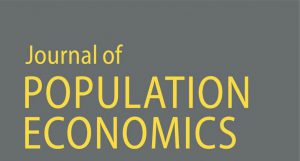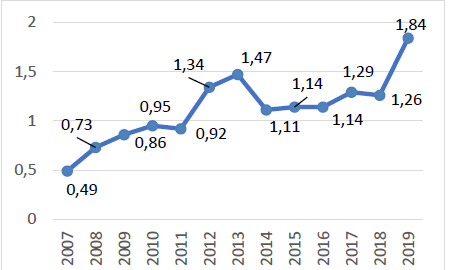Report of the Editor-in-Chief 2020 (23 July, 2020) PDF of Report
The Journal of Population of Economics is an international quarterly that publishes original theoretical and applied research in all areas of population economics, household economics, and human resources. This report contains information about the Journal and its editorial process in the past year and some earlier years.

The number of submissions has substantially increased over recent years (Figure 1). Between 2011 and 2013, the Journal received about 400 submissions per year; by 2016 the number of submissions neared 500, and in 2019, 617 manuscripts were received. The inflow appears to be holding steady; as of the end of July 2020, the journal had received 485 new manuscripts; during the same period last year, a much smaller number of manuscripts (327) had been received.

In line with past years, the largest single share of submissions made in 2019 were from corresponding authors based in Europe (Figure 2). Over 40% of all submissions originated from Europe, and nearly one-third (29%) of submissions came from authors based in Asia and the Middle East. Under one-fifth (20%) of submissions came from authors based in North America. The remaining submissions came from contributors from Africa (4%), Oceania (Australia and New Zealand; 5%), and South and Central America (3%).

Figure 3 contains the internet visits to the Journal on the Springer website from the world regions. With over a third of visits coming from North America and 29% from Europe, followed by the Asia-pacific region (22%), the Journal is globally accessed and read.

Figure 4 shows that the average number of days between submission and first decision has generally declined over time. Despite a slight uptick in the turnaround time for first decisions between 2015 and 2016, which may be partially attributed to the increased volume of submissions, there was a substantial reduction in turnaround time in following years. In 2019, the average time for first decisions was 30 days. The Journal is committed to keep the time between submission and decisions low, including eventual publication. Since 2013 the Journal has executed a desk rejection policy to provide authors with an early signal for better targeting of their work. The large number of submissions combined with an annual quota of 40 manuscripts keeps the acceptance rates of the Journal very low.
Table 1 shows three acceptance rate measures: 1) the number of manuscripts accepted in a given year as a share of all final decisions made in that year; 2) the number of published articles in a given year as a share of all submissions in that year; and; 3) the number of articles published in a given year divided by the number of the previous year’s submissions.

The number of accepted papers (submitted at any point in time) in a given year as a share of all decisions made in that year has shifted over time. Compared to 9.5% in 2017, the acceptance rate has declined from 7% in 2018 to 4.9% in 2019. If acceptance rate is measured as the number of published manuscripts as a share of total submissions received in that year, the acceptance rate was slightly higher, at 6.5% in 2019 (or 40 manuscripts from among 617 submissions), falling 7.6% in 2017 and 7.1% in 2018. Measuring the acceptance rate as the number of publications as a share of the number of submissions received in the previous year (2018) would yield a 2019 rate of 7.1%, which is lower than the previous years (8.1% in 2017 and 7.6% in 2018).

Table 2 reports the status of papers submitted in the given year for years 2017 – 2019. The Journal’s Impact Factor has increased substantially over time (Figure 5). In 2019, the just published simple Impact Factor was 1.840, and the 5-year Impact Factor was 2.353. The Journal ranked 120/371 in economics and 11/29 in demography in 2019. As of July 2020, the Journal’s IDEAS/RePEc ranking was 77/2,485 (based on the Simple Impact Factor 15.682, for Journals and all years).

The Journal is ranked in: Social Science Citation Index, Journal Citation Reports/Social Sciences, SCOPUS, EconLit, Google Scholar, EBSCO Discovery Service, ProQuest, CAB International, ABS Academic Journal Quality Guide, Academic OneFile, Academic Search, Bibliography of Asian Studies, CAB Abstracts, CSA Environmental Sciences, Current Contents/Social & Behavioral Sciences, ECONIS, ERIH PLUS, Gale, Global Health, International Bibliography of the Social Sciences (IBSS), JSTOR, OCLC, Research Papers in Economics (RePEc), Review of Population Reviews, SCImago, and Summon by ProQuest.

Klaus F. Zimmermann,
Editor-in-Chief
Journal of Population Economics

